Log in or create new account to save this product to your wishlist.
Creating a new lawn from scratch (including a step-by-step plan!)
Creating a new lawn from scratch takes a little time - but it's all in the preparation. Find out what type of seed to use, how to prepare the ground, and how to maintain your seedlings once they've germinated.
Latest articles
7 MIN 22 Jul How to keep your lawn in shape this summer 9 MIN 15 Jul Watering Your Garden: 10 Top Tips! 11 MIN 15 Jul Is Your Grass Type Right for your Garden? 11 MIN 10 Sep Create Your Low-Maintenance Garden – Tips and Ideas 11 MIN 08 Sep The Ultimate Guide to Choosing the Perfect Hedges for Your Garden 12 MIN 30 Aug The Top 20 Evergreen Climbers to Transform Your GardenIs your lawn looking tired and unloved (despite your many efforts)? Perhaps you’ve moved into a new home, and the previous residents severely neglected the garden? It might be time to think about creating a new lawn from scratch?
- Laying a lawn: what you need to know
- What is the lawn going to be used for?
- What type of soil do you have?
- Creating a new lawn: adding organic matter
- Creating a new lawn: which type of grass seed should you use?
- Creating a new lawn in 10 easy steps
- New lawn aftercare
Now, don’t panic – it’s not as complicated a task as you might think. But you need to understand:
- How to prepare your soil
- Your soil type and the micro-climate
- What type of grass seed is most suited to your soil, your needs, and your climate
This article explains everything you need to know about laying a new lawn – guiding you through the process in ten easy steps.
Ready? Let’s go!
Laying a lawn: what you need to know
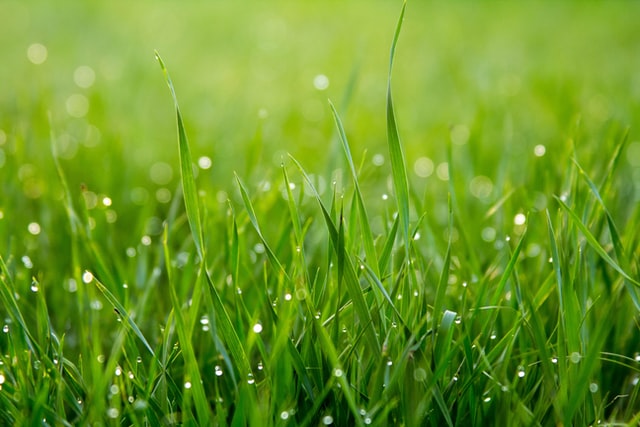
Before you pick up a single garden tool or buy your grass seed, it’s important to consider our checklist:
- What is the lawn going to be used for?
- What type of soil do you have?
- Is your lawn in full sun or in the shade? Or both?
- What type of grass you’re hoping for
- How large is your lawn going to be?
What is the lawn going to be used for?
This seems like an odd question, but it’s actually crucial to consider the likely purpose of your lawn.
Are you looking for a purely ornamental lawn – that quintessential English manicured lawn look? Bear in mind that this type of lawn isn’t usually suited to heavy use.
Or will your lawn see a lot of springtime and summer activities, such as ball games, BBQs, and family get-togethers?
The level of use determines the perfect type of seed you’ll need.
What type of soil do you have?
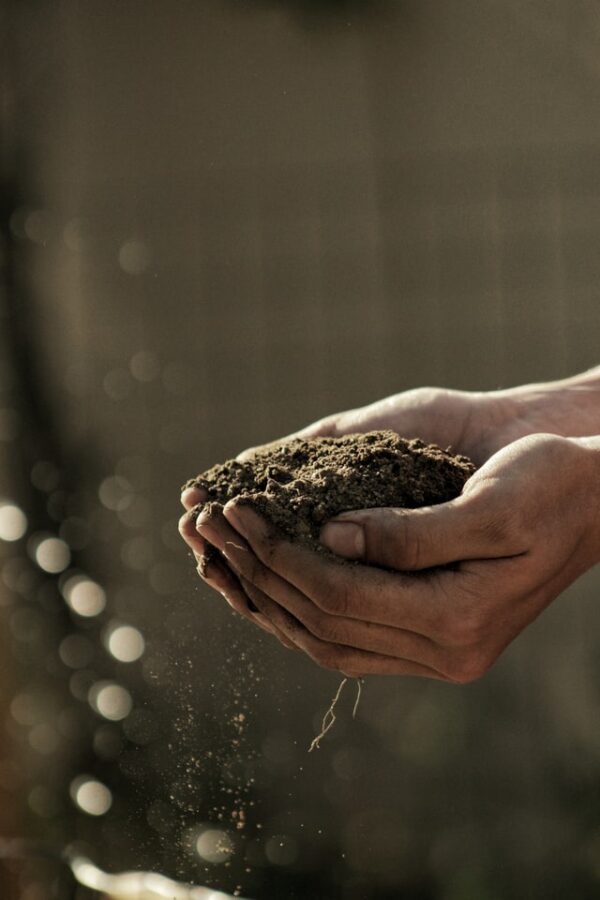
Each UK region has a different predominant soil type, ranging from heavy clay to sandy.
It’s helpful to recognise your soil type because it dictates the preparations you’ll need to make, the variety of grass that will thrive, and the type of fertiliser/soil improver you should use.
Clay soil
Clay soils are nutrient-rich but moisture-retentive. This means that your soil contains most of the necessary nutrients for healthy grass but requires regular aeration to assist with drainage; otherwise, it could flood.
In the winter, clay soils are wet and cold, while they bake dry in the summer.
Sandy soil
Sandy soils drain extremely well and probably don’t need aerating as regularly. However, nutrients are easily washed away from sandy soil, so you may need to fertilise the ground more frequently.
Sandy soils often lean towards the acidic side of the pH table, which can inhibit the healthy growth of your grass plants. You’ll need to add lawn lime to balance the pH.
Silt soil
Silt soils are light and fertile but also moisture-retentive, which easily compacts. Compacted soil inhibits the growth of deep roots, reducing the resistance of your grass plants.
Loam soil
Loamy soil is the best of both worlds – it’s a mix of clay, sand, and silt. This soil type drains well but holds its nutrients, giving it excellent fertility.
Creating a new lawn: adding organic matter
Adding organic matter such as leafmould or compost to your earth helps improve the soil consistency – it loosens up clay soil and improves the drainage, while it helps sandy soil hold onto its moisture.
There’s a simple way to determine your soil type:
- Take a handful of soil and squeeze it in your palm for a couple of seconds
- Release your palm
- If the soil falls apart again, you have light, sandy soil. You have heavy clay soil if the earth holds together in a perfect replica of your inner clenched fist.
Knowing your soil type helps determine which fertilisers to use and whether you need to add organic improvers.
Creating a new lawn: which type of grass seed should you use?
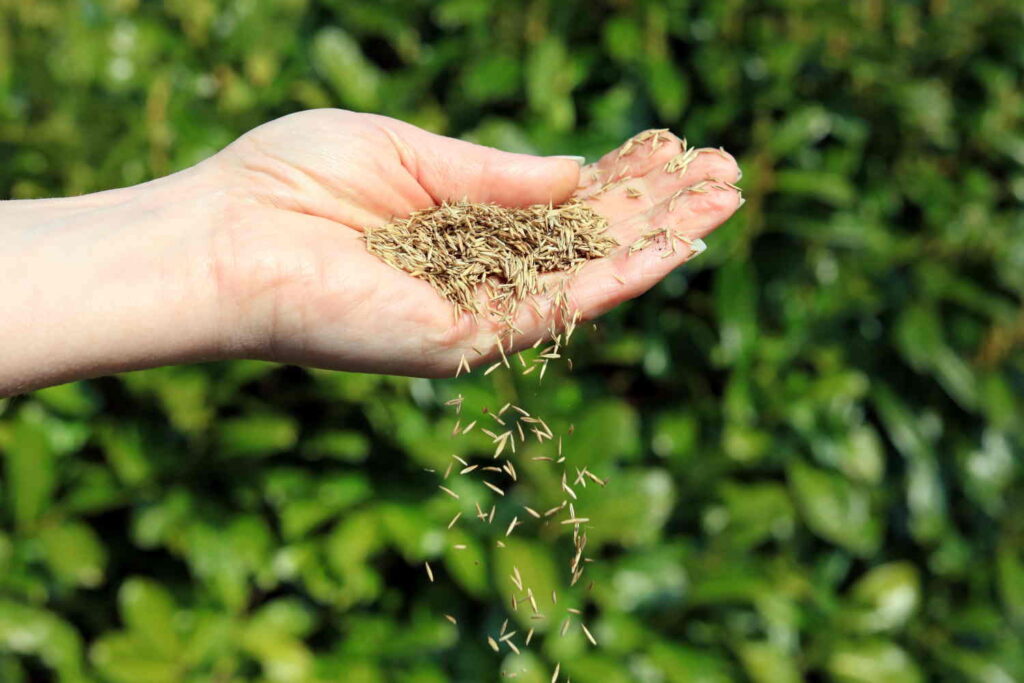
Once you’ve established your soil type and the intended purpose of your new lawn, you can make some decisions about the variety of grass seeds to use.
There are many different types of grass seeds on the market, and it can be tempting to go for the cheapest brand you can get hold of. But, like most things in life, you get what you pay for, and it’s often a false economy to go for entry-level products.
Generally, cheap seed has a low germination rate, and the resulting grass plants lack the resistance of premium seed. MOOWY’s grass seeds range in price and offer high-resistance lawns that last for years.
Creating a high-use lawn
If you’re looking for grass that will tolerate intensive use, such as ball games, you need a grass-type that’s durable and grows densely.
MOOWY’s Sports & Fun grass seed is produced by the same company that supplied grass seed for the FIFA 2018 World Cup stadiums. Sports & Fun germinates quickly and grows densely, meaning it’s up for a proper beating – perfect for children to run around on and play games.
And if the grass gets damaged, it recovers quickly and is strong enough to survive a harsh British winter.
But we all know that British weather is unpredictable! Sports & Fun is robust enough to endure both drought and heavy rainfall.
Creating a shady lawn
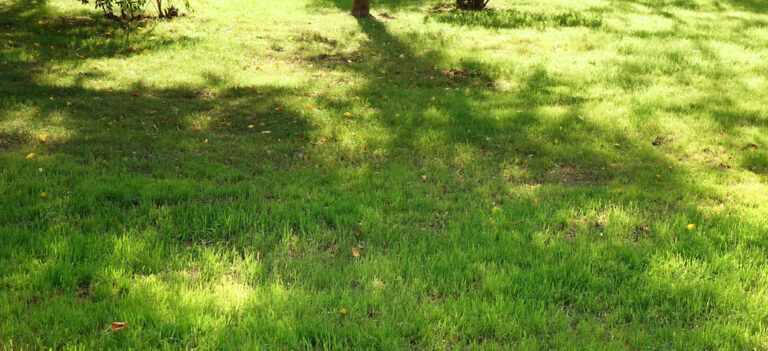
If your lawn is south-facing, you’ll enjoy all-day sunshine. But not everyone is that lucky, with shaded gardens that get dappled sunlight due to trees, shrubs, and other obstacles, such as buildings.
Of course, there are benefits to shaded gardens: they never get too hot, and – in general – they’re reasonably private due to the proliferation of trees and shrubs that throw the shade across the grass.
But most grass types need lots of sun.
Luckily, MOOWY’s Shade & Sun grass seed is designed to thrive in lawns in full or partial shade. With a high mix of red fescue and Kentucky bluegrass (don’t worry – it’s not blue!), Shade & Sun is hardy enough to thrive with little direct sunlight.
Perhaps your existing lawn struggles to grow underneath a shady tree? Try overseeding with Shade & Sun in the shaded areas for excellent coverage.
And check out our article about growing grass in shaded areas.
Creating an ornamental lawn
If you want the type of quintessential manicured English lawn that you see in the grounds of Downton Abbey, you need MOOWY’s Premium Lawn grass seed.
Ornamental lawns are, by nature, low-use lawns – not intended as play lawns. However, this grass type – high in fine-leafed red fescue – feels like a carpet to walk on.
Tolerant to much shorter mowing, this is the type of grass you might see on a golf putting green. And it grows more slowly than your average lawn, so it requires less mowing.
Patching up your existing lawn
Maybe you don’t want to start from scratch? Perhaps you’re looking to overseed your existing lawn?
First, it’s essential to clear your existing lawn of moss, thatch, and weeds, so it will need a good scarification to prepare for overseeding. This involves removing the thatch layer that sits on the topsoil.
MOOWY’s Power Lawn grass seed germinates rapidly, producing a hardy lawn that will last through extreme weather and heavy use, with strong resistance to disease and fungi.
Creating a new lawn in 10 easy steps
It’s time to get to work!
Step 1: Remove Weeds!
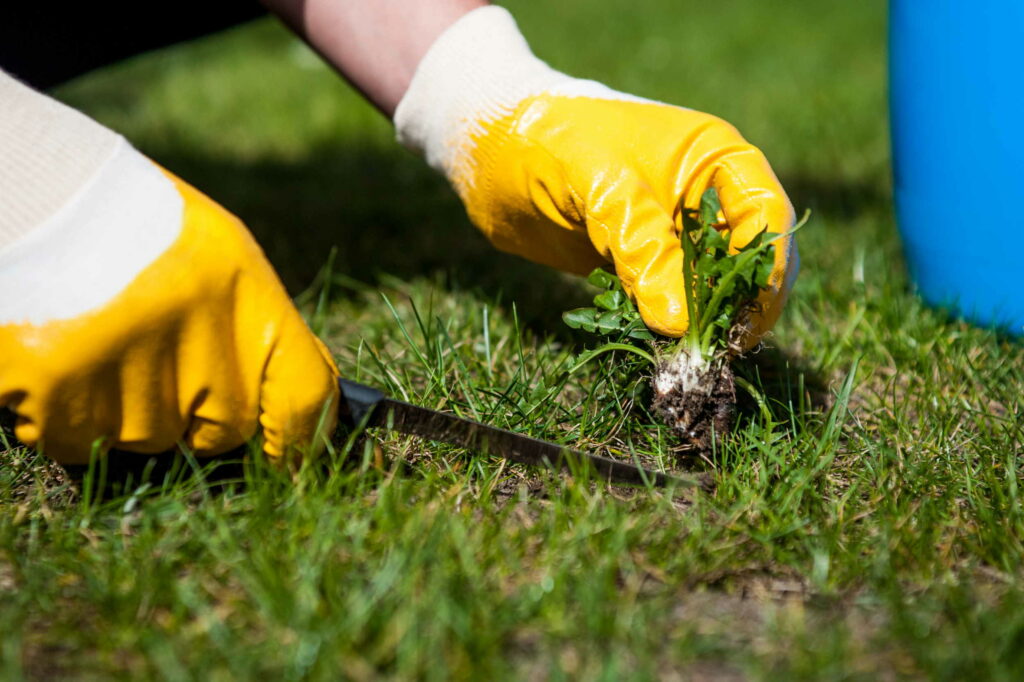
You need a clean slate before you re-lay your lawn. Chances are, you’re going to need to remove the old turf (Step 2), but you’ll still need to kill off the weeds to ensure their roots don’t endure beyond all of your efforts!
So, remove the weeds by hand (possibly with a weed remover tool) or with a permitted weed killer.
If you’re using a chemical weed killer, make sure you use one that doesn’t affect new seeds; otherwise, it will prevent your new seed from germinating.
Step 2: Remove the old turf

This is a little back-breaking but well worth the effort. If you’re laying a new lawn over old, weedy turf, then it’s best to remove it with a turf lifter.
Step 3: Plough and level the soil
Once you’ve removed the old turf, it’s time to plough the soil using a rotavator. You need to go down to a depth of 20-25cm, so it’s a fair old task to do by hand. You can, of course, turn the top layer of soil with a fork, but it’s pretty back-breaking.
You can, of course, hire a rotavator; that’s much quicker and easier.
Once you’ve turned the soil over, give it two weeks to settle. Try not to walk on the earth too much during this period, but give it a good watering to help it settle.
This two-week window is essential for optimal results because it will give any weeds remaining in the earth time to spring back to life. Remove them by hand, then level out the surface with a rake or levelling tool.
This is also the stage to address your soil type. Adding soil improver, such as well-rotted (weed-free) compost, will help improve drainage for clay soil and moisture-retention for sandy soil.
Then, use a roller to ensure a flat, even soil surface.
Step 4: Fertilise your soil
Give your new seed an optimal chance to germinate and establish by fertilising the soil before you sow. MOOWY’s Lawn Starter fertiliser contains plenty of phosphorus, promoting root development for disease- and drought-resistant grass.
Use 25g per m², and rake it in.
| Time of year | At what stage? | Which fertiliser? |
| Feb-Oct | When sowing | Lawn Starter |
| March-Oct | 8 weeks after sowing | Easy Mow |
| Sept-Oct | Each year before winter | All-Round |
Once established, fertilise your new lawn three times within the first year – twice in the first growing season. Then, fertilise three to four times a year moving forward. Check out our complete guide to fertilising your lawn.
Step 5: Sowing your new grass
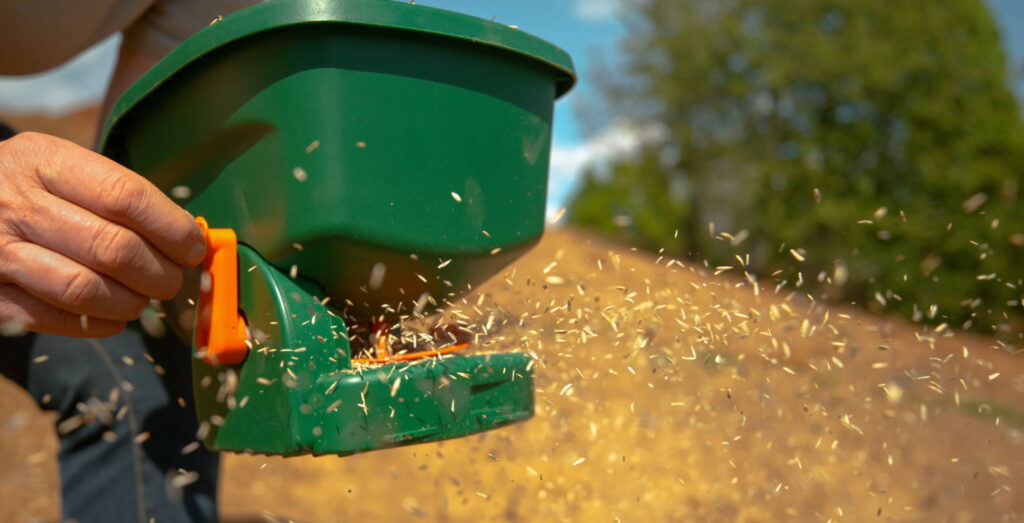
This is the fun bit: sowing your new grass seed. Sow by hand if you have a small lawn or use a spreader for a larger surface area.
Click here for our in-depth guide to sowing grass seed, but to summarise:
- You’ll need 34g of seed per m². Calculate how much you’ll need before you start sowing.
- Divide the seed into two measures. Sprinkle the first part lengthwise across the soil and the second part widthwise, covering the same area.
- Lightly rake the grass seed to ensure optimal soil contact. Don’t cover the seed with soil – it won’t germinate evenly.
Step 6: Press the grass seed
Use a lawn roller to press the seed onto the soil surface. You can do this with your feet if you have a smaller lawn.
You need direct contact between the seed and the soil surface for best results. This stops the seed from getting washed away when it rains or when you water.
Step 7: Water!
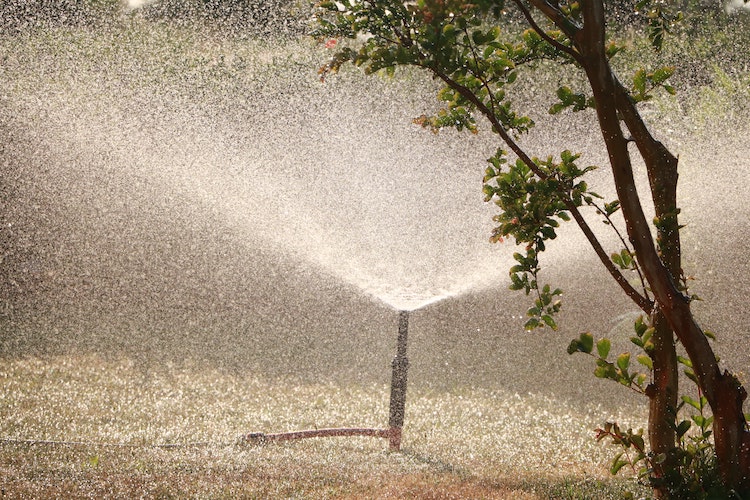
It’s better to water lightly four times a day than to water heavily once a day; otherwise, you risk disturbing the seed, which will create an uneven covering.
Keep watering daily until the seeds germinate. This should take around two weeks.
Step 8: Reseed bald spots
Despite your efforts, some seed is likely to have moved during the process of sowing, so you may notice a few bald spots around your new lawn.
Wait two weeks after initial germination to determine whether there are, indeed, any bald spots. And overseed those patches with new seed.
TIP: When buying grass seed, buy 10% more than you actually need. This allows you to overseed later if required.
Step 9: The first mowing
Leave it 21 days after the grass has germinated before you mow, and avoid walking on your new grass plants during this time.
Never cut more than ⅓ of the length of the grass blade, or you’ll weaken the plant. If you want your grass shorter, wait a few days and mow another ⅓ of the length. Cutting every 3 to 5 days makes your grass grow faster.
Step 10: Limit lawn treading
You should avoid walking on your grass seed throughout its entire first season to ensure you don’t damage the vulnerable young plants. Give it a good few months before you start using your lawn, and it will repay you with many years of beautiful service.
New lawn aftercare
Your new lawn should give you many years of happy times! But, for optimal results, it’s essential to instil a good maintenance regime.
To maintain your lawn, ensure that you:
- Mow regularly
- Fertilise the earth three to four times a year
- Neutralise acidity with lawn lime once a year
- Scarify every year (or every other year)
- Overseed whenever bald patches appear – this will help prevent moss and weed infestations
- Water your lawn during dry spells
Ready to get started? Or do you need more information?
We hope we’ve given you a good outline of the do’s and don’t’s to successfully create a new lawn from scratch. But if you’ve got any questions, please don’t hesitate to get in touch.
Send us an email, and we’ll get back to you promptly.
Happy gardening! Thanks for reading.
Leave a comment
Your answer will be displayed on the site and the interested party will be notified by email.
Leave a comment
Have a question or want to share your experience? Leave us a comment.
Read more
The best tips and tricks for a lush green lawn
 7 MIN
02 Jun
The Great Grass Seed Comparison!
7 MIN
02 Jun
The Great Grass Seed Comparison!
 Scarifying Kit
All products after scarifying | Quickly restores the lawn after scarifying | Outsmart weeds quickly with the use of this kit
From: € 39.99
Scarifying Kit
All products after scarifying | Quickly restores the lawn after scarifying | Outsmart weeds quickly with the use of this kit
From: € 39.99
 Spring Lawn Care Kit
MOOWY’s choice for the spring | Quick recovery of your lawn after winter | A strong lawn prevents weeds
From: € 25.99
Spring Lawn Care Kit
MOOWY’s choice for the spring | Quick recovery of your lawn after winter | A strong lawn prevents weeds
From: € 25.99
 Long Lasting Lawn Fertiliser
Effective for 90 days | See results in 14 days! | Suitable for all types of grass and soil
From: € 13.99
Long Lasting Lawn Fertiliser
Effective for 90 days | See results in 14 days! | Suitable for all types of grass and soil
From: € 13.99
Do you want a lawn calendar?
🌱 All important maintenance moments for your lawn during the year. Leave your email and we will send you the lawn calendar for free.
Enter your email
Receive the lawn calendar in the mail
Enjoy a green lawn all year round!




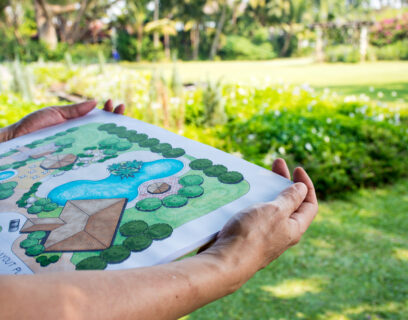






Comments (0)
There are no comments yet. Well then, what are you waiting for to
Be the first to write your comment!inaugurate this pretty page?
Do you have some comments?